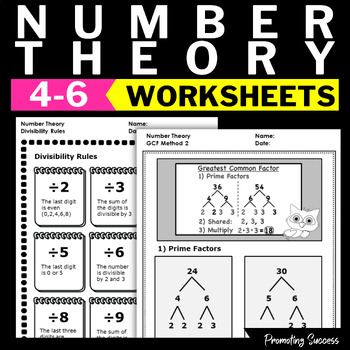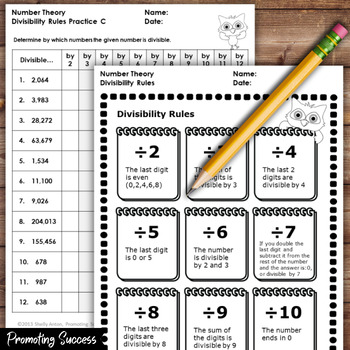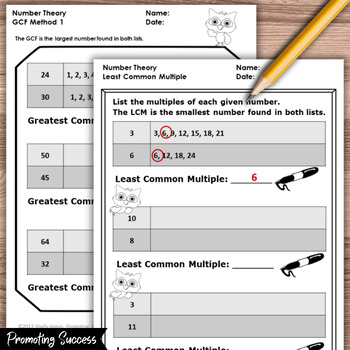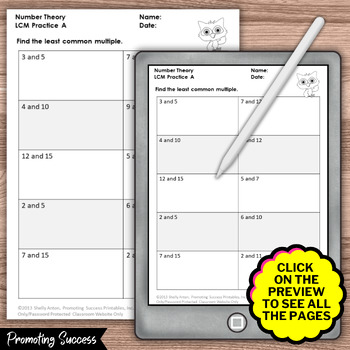Divisibility Rules Prime and Composite Numbers Prime Factorization GCF and LCM
- PDF
- Internet Activities
- Easel Activity
What educators are saying
Also included in
- In this number theory worksheets bundle for your 5th and 6th grade students to practice and review Common Core skills, including divisibility rules, prime or composite numbers, factors and multiples, prime factorization, factor trees, least common multiple (LCM) and greatest common factor (GCF). YouPrice $28.00Original Price $47.75Save $19.75
- You will download a bundle of 4th and 5th grade math and literacy resources, including summarizing, hurricanes, money word problems, and number theory worksheets and task cards. You will download both print and digital EASEL PDF formats for your convenience.This bundle was created to give teachers aPrice $11.50Original Price $16.50Save $5.00
Description
Divisibility Rules Packet: You will download number theory worksheets for your 4th grade, 5th grade, 6th grade, and special education math students to practice divisibility rules, greatest common factor, least common multiple (GCF and LCM), prime and composite numbers, factoring, and prime factorization. These divisibility rules worksheets align with 4th, 5th, and 6th grade Common Core math standards and will supplement your curriculum as an informal pre-assessment, as an extra practice or review activity, or intervention work.
Contents include:
- Number theory definitions anchor charts for prime number, factors, prime factorization, common factors, and greatest common factor
- Divisibility rules anchor charts for dividing by 2, 3, 4, 5, 6, 7, 8, 9, 10, 11, and 12
- Divisibility rules practice in checkmark style (3 worksheets)
- Color to highlight the prime numbers on a 1-100 number chart
- Determine if a number is prime or composite in checkmark style (3 worksheets)
- List the factors of the numbers given (3 worksheets)
- Find the greatest common factor (GCF) of the two numbers given examples and practice (method 1)
- Prime factorization trees examples
- Complete the prime factorization trees
- Find the greatest common factor (GCF) of the two numbers given examples and practice (method 2)
- Find the GCF (3 worksheets)
- Least common multiple definitions anchor charts for multiple, common multiple, and least common multiple
- Find the LCM of two numbers given (4 worksheets)
For your convenience, this divisibility rules packet comes in both TPT digital EASEL and printable PDF resource formats. Answer keys are provided.
☛ Please click on the PREVIEW above.
Studying number theory, particularly topics related to prime numbers, divisibility rules, factorization, least common multiple, and greatest common factor, is essential for students because it provides a foundational understanding of integers and their properties. This knowledge forms the basis for more advanced mathematical concepts and is crucial for various practical applications in fields like cryptography, computer science, and engineering. Additionally, it fosters critical thinking and problem-solving skills, helping students develop a deep appreciation for the elegance and significance of number theory in mathematics.
✔︎ Common Core Math Standard Lesson Plan:
CCSS.MATH.CONTENT.6.NS.B.4
Find the greatest common factor of two whole numbers less than or equal to 100 and the least common multiple of two whole numbers less than or equal to 12. Use the distributive property to express a sum of two whole numbers 1–100 with a common factor as a multiple of a sum of two whole numbers with no common factor. For example, express 36 + 8 as 4 (9 + 2).
➔➔ Click HERE if your prefer this packet in Google SLIDES format.
$$$ Click HERE to see this packet as part of a money-saving bundle.
➥ Click HERE to go back to my storefront and browse the categories on the left.
▶︎ DIGITAL COMPATIBLE RESOURCE:
- Through the EASEL by TPT platform, you will be able to annotate and customize the PDF using overlays. Underlying content is not editable. You will then be able to assign chosen pages to your students.
▶︎ TERMS OF USE:
- Single classroom use only.
- Password protected classroom websites only, not to be found on Google search.
- No commercial use, including Outschool, etc. Contact me if you need a commercial use license.
- No reselling in any digital or print formats.
- Click HERE to see my most current terms of use.
⚙️ CUSTOMER TIPS:
- Click HERE to sign up for my newsletter with flash freebies, secret sales, and more!
- Click on the ★ above to follow my store. You will receive email notifications from TPT of newly listed products and freebies.
- Leave feedback to earn TpT credit points to save money on future products.
Thank you so much for all you are doing for kids!
❤️ Shelly Anton
Promoting Success for You and Your Students!








